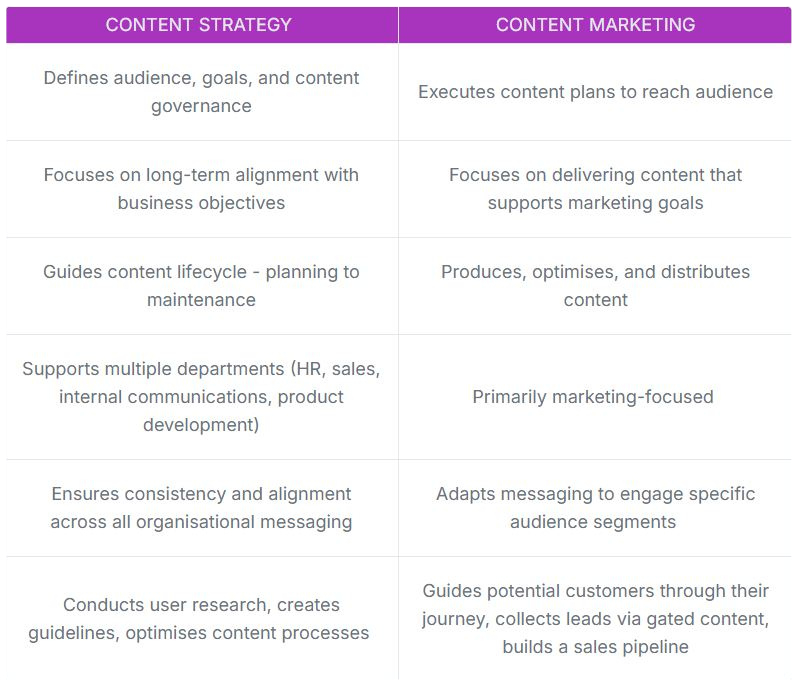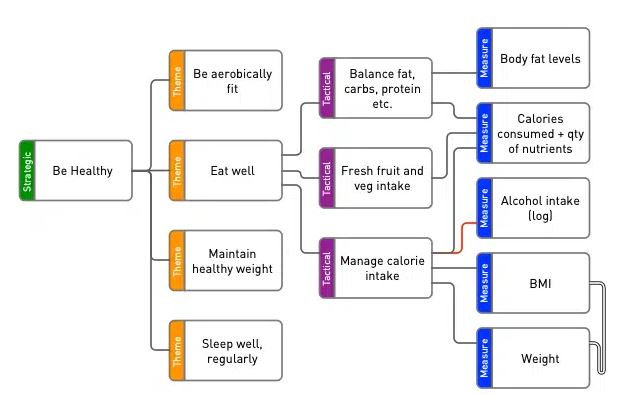This is relevant for anyone involved in planning and producing content. Aligning strategy with execution helps ensure that content supports business goals, stays consistent and delivers measurable results.
Imagine this: You’ve spent months creating the perfect content strategy. You’ve defined your audience, mapped out their journey, set clear objectives and scheduled an editorial calendar for the next three months. But then… nothing happens.
No blogs are published, no social media posts go live and the meticulously planned content sits in a folder, untouched. Why? Because strategy without execution is just an idea. And that’s where content marketing comes in – it’s one of the things that brings content strategy to life.
For many, the line between content strategy and content marketing is blurry. They might sound like two ways of saying the same thing but they serve different roles. Content strategy is the architecture, designing the blueprint. Content marketing is the build, turning those plans into something concrete.
For many people, the line between content strategy and content marketing is blurry. They might sound like two ways of saying the same thing, but they have different roles. Content strategy is the architecture – designing the blueprint – while content marketing is the build – turning those plans into something concrete.
So how exactly do these two disciplines complement each other? And why is it important to understand? Let’s break it down.
Defining Content Strategy and Content Marketing
Content strategy ensures that all content aligns with an organisation’s broader business goals and meets the needs of its audience. Kristina Halvorson, a recognised authority in the field, defines it as: “Content strategy plans for the creation, delivery and governance of useful, usable content” (Halvorson & Rach, 2012).
Content marketing, on the other hand, refers to the tactical execution of initiatives that support marketing objectives. According to the Content Marketing Institute (CMI), it involves creating and distributing valuable, relevant content to attract and engage a clearly defined audience – ultimately driving profitable customer actions. These actions can be seen as increased brand awareness, higher website traffic, lead generation, or direct sales conversions, to name a few (Content Marketing Institute, 2025).
While these definitions provide clarity, it is important to understand the distinctions between the two. A common misconception is that content strategy is solely tied to marketing. In reality, it extends past marketing to support different functions across a business – for example, internal communications, recruitment, sales and product development.
Key Differences Between Content Strategy and Content Marketing
To further differentiate content strategy from content marketing, let’s compare them based on their focus areas:

The Symbiotic Relationship Between Content Strategy and Content Marketing
While content strategy and content marketing have distinct roles, their collaboration is crucial for achieving business objectives. Here’s how they complement each other:
- Foundation and Execution: A well-crafted content strategy provides the blueprint, outlining the brand’s voice, messaging and overall content direction. It ensures that these segments are aligned with the existing business objectives. Content marketing brings this blueprint to life by producing and distributing content that aligns with the strategy.
- Consistency and Connection: Content strategy ensures uniformity in messaging across all platforms and touchpoints. Content marketing reinforces this consistency by delivering tailored content that resonates with the target audience, building trust and brand loyalty. A lack of strategic alignment leads to disconnected marketing efforts, where content feels fragmented rather than part of a cohesive brand narrative.
- Adaptation and Responsiveness: A strong strategy allows content marketers to adapt according to data, market trends and audience preferences while staying true to the brand’s core message. This ensures that content remains relevant and engaging - not only in marketing efforts but also in internal communications, recruitment, sales and beyond.
Practical Benefits of Implementing Content Strategy & Content Marketing
Successfully integrating content strategy and content marketing offers several advantages:
- Enhanced Audience Engagement: A strategic approach ensures that content is not only relevant and timely but also, that it anticipates future needs and interests of the audience. By aligning with the user journey, content strategy and marketing work together to engage audiences proactively, keeping them interested and invested over time.
- Improved Resource Allocation: With a clear strategy, organisations can allocate resources effectively, focusing on content that aligns with business objectives and offers the highest return on investment. This also reduces wasted efforts on unsuccessful content projects. This can prevent unnecessary production of unneeded content, which if used, can fail and never come to fruition – all because of a lack of strategic alignment.
- Measurable Outcomes: A well-crafted strategy and execution plan allow for the setting of clear KPIs and metrics, enabling the measurement of content effectiveness and consequently informing future initiatives.
Measuring Success: KPIs and the Importance of a Goal Hierarchy
One key takeaway from our Content Marketing course by Robert Weller was the importance of setting the right content marketing goals. Without well-defined goals, it becomes nearly impossible to determine whether your content marketing efforts are a success or a bust.
But how do you measure success? How do you know if your content is making an impact? The answer lies in selecting suitable Key Performance Indicators (KPIs) which are part of a broader goal hierarchy, ensuring that content marketing aligns with wider business objectives.
A visual representation of this is the KPI tree, which maps how each level of organisational goals interconnect and ensure alignment across business functions. Each level of the hierarchy builds upon the one above it, creating a clear path from strategic vision to execution:
- Business Goals: These are the high-level objectives that drive the company’s success, such as "Increasing revenue by 15% in Q4". These goals define the ultimate purpose of all marketing and content efforts.
- Marketing Goals: These specify how marketing contributes to achieving business success such as "Generating 5,000 new leads via content". Marketing serves as the bridge between strategic intent and actionable plans.
- Content Goals: These focus on how content marketing supports marketing objectives, such as "Improving organic traffic by 20%". Content acts as the tool that delivers value and engages the audience.

This ensures content strategy does not operate in isolation. Each piece of content should serve a purpose that supports marketing and ultimately business outcomes. Without a clear structure, content efforts risk becoming fragmented and ineffective.
Conclusion
In essence, content strategy shapes the "why" and "how", while content marketing addresses the "what", "where" and "when". When combined, they create a connected content experience that yields real results. Whether you’re building a brand, growing an audience or creating content for a company, understanding how content strategy and content marketing work together is truly important – it creates a competitive advantage.
A strong strategy ensures that content has a clear purpose, while effective marketing brings it to life and delivers it to the right audience. When aligned, content doesn’t just capture attention – it builds trust, sustains engagement and drives meaningful business outcomes.
Where to go from here #
References #
Content Marketing Institute. (2025). What Is Content Marketing? Retrieved from https://contentmarketinginstitute.com/what-is-content-marketing/. [29.3.2025]
Content Marketing Institute. (2013). How Content Strategy and Content Marketing Are Separate But Connected. Retrieved from https://contentmarketinginstitute.com/articles/content-strategy-content-marketingseparate-connected/. [29.3.2025]
Halvorson, K., & Rach, M. (2012). Content Strategy for the Web, Second Edition. New Riders.
This article is a student-written report on a part of the course "Content Marketing" in the M.A. program in content strategy. It has been authorised by the instructor Robert Weller.

